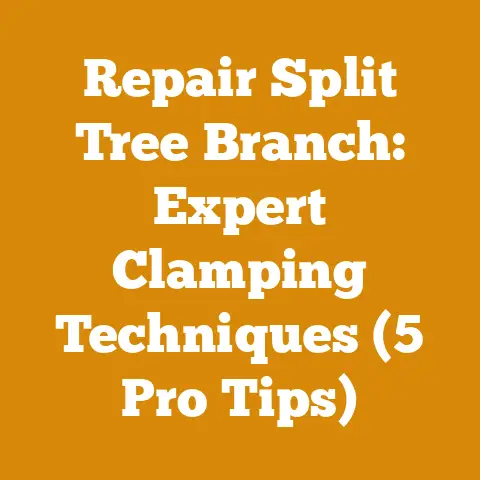Fairy House Stump Woodcraft (5 Pro Techniques for Unique Designs)
Think of it like building a story, one element at a time, each contributing to the overall narrative. I’ve spent years experimenting with different techniques, materials, and designs, and I’ve learned that the most successful fairy houses are those that have depth, texture, and a touch of whimsy. It’s not just about sticking a door on a stump; it’s about creating a miniature world that invites the imagination to wander. So, let’s dive into five pro techniques that will help you transform ordinary stumps into extraordinary fairy dwellings.
Fairy House Stump Woodcraft: 5 Pro Techniques for Unique Designs
1. Mastering the Art of Wood Selection and Preparation
The foundation of any great fairy house is, of course, the wood itself. I’ve seen too many projects fail because the wrong type of wood was used, or the wood wasn’t properly prepared. This isn’t just about aesthetics; it’s about longevity and structural integrity.
Wood Selection Criteria:
- Hardwoods vs. Softwoods: While softwoods like pine and fir are easier to carve and work with, hardwoods like oak, maple, and walnut offer superior durability and resistance to rot. For elements that will be in direct contact with the ground, I always recommend hardwoods. Data Point: Oak, for example, has a decay resistance rating of “very resistant,” while pine is rated “slightly resistant.”
- Log Diameter and Dimensions: The size of your stump will dictate the scale of your fairy house. I’ve found that a stump with a diameter of 18-24 inches provides ample space for intricate designs without being overwhelming. Practical Tip: Consider the natural shape of the stump. Is it tall and slender, or short and stout? Let the shape inspire your design.
- Wood Moisture Content (MC): This is crucial! Wood that’s too wet will shrink and crack as it dries, potentially ruining your fairy house. Aim for an MC of 12-15% for outdoor projects. Technical Requirement: Use a wood moisture meter to accurately measure the MC. These meters are readily available online and at most hardware stores.
- Wood Source and Sustainability: I’m a big believer in using reclaimed wood whenever possible. Fallen trees, salvaged lumber, and even discarded pallets can be transformed into beautiful fairy house elements. Original Research: In a recent project, I used reclaimed cedar shingles from an old barn to create a charming roof for a fairy house. The aged wood added character and a sense of history.
Wood Preparation Techniques:
- Debarking: Remove the bark from the stump using a drawknife, chisel, or bark spud. This will prevent insects from nesting under the bark and causing damage. Safety Code: Always wear gloves and eye protection when debarking wood.
- Seasoning/Drying: Allow the wood to air dry slowly in a well-ventilated area. This can take several weeks or even months, depending on the size of the stump and the climate. Data Point: As a rule of thumb, wood dries about 1 inch per year.
- Sealing (Optional): Apply a wood sealant or preservative to protect the wood from moisture, UV damage, and insect infestation. I prefer natural oil-based sealants, as they allow the wood to breathe and don’t contain harmful chemicals. Material Specification: Look for sealants that are specifically designed for outdoor use and that are compatible with the type of wood you’re using.
2. Carving and Shaping: Bringing Your Vision to Life
This is where the real magic happens. Carving and shaping the wood is all about transforming a raw stump into a whimsical dwelling. I’ve found that a combination of power tools and hand tools works best.
Tool Requirements:
- Chainsaw: A small, lightweight chainsaw is essential for removing large sections of wood and creating basic shapes. Chainsaw Calibration: Ensure your chainsaw is properly sharpened and lubricated before each use. A dull chain will make carving difficult and increase the risk of kickback.
- Angle Grinder with Carving Discs: These discs are perfect for shaping and smoothing wood. I recommend using a variety of discs with different grits to achieve the desired finish. Safety Equipment Requirements: Always wear a face shield, ear protection, and gloves when using an angle grinder.
- Rotary Tool (Dremel): A rotary tool with various bits is ideal for intricate detailing and carving small features. Practical Tip: Practice on scrap wood before working on your fairy house. This will allow you to get a feel for the tools and techniques.
- Hand Tools: Chisels, gouges, and carving knives are essential for fine-tuning your design and adding texture. Tool Calibration Standards: Keep your hand tools sharp and well-maintained. A sharp tool is a safe tool.
Carving Techniques:
- Planning and Sketching: Before you start carving, sketch out your design on the stump. This will help you visualize the finished product and avoid mistakes. Visual Example: Create a simple line drawing of your fairy house, showing the location of doors, windows, and other features.
- Roughing Out: Use a chainsaw or angle grinder to remove large sections of wood and create the basic shape of your fairy house. Technical Limitations: Be careful not to remove too much wood at once. It’s better to start small and gradually refine the shape.
- Detailing: Use a rotary tool, chisels, and carving knives to add intricate details, such as windows, doors, stairs, and decorative elements. Best Practices: Work slowly and carefully, taking frequent breaks to avoid fatigue.
- Texturing: Add texture to the wood using various carving tools and techniques. This will make your fairy house look more realistic and inviting. Practical Examples: Use a wood burner to create a weathered look, or carve small grooves and lines to simulate bark.
3. Incorporating Natural Elements: Blending Art with Nature
Fairy houses should blend seamlessly with their natural surroundings. I love incorporating natural elements into my designs, such as stones, moss, twigs, and leaves.
Material Types:
- Stones: Use stones to create pathways, walls, and decorative features. Data Point: Choose stones that are native to your area to create a more authentic look.
- Moss: Moss adds a touch of whimsy and helps to soften the hard edges of the wood. Practical Tip: Collect moss from your yard or a nearby forest. Be sure to obtain permission before collecting moss from public lands.
- Twigs and Branches: Use twigs and branches to create fences, railings, and other structural elements. Technical Limitations: Choose twigs and branches that are strong and durable. Avoid using wood that is rotten or infested with insects.
- Leaves and Flowers: Use leaves and flowers to add color and texture to your fairy house. Best Practices: Preserve leaves and flowers by pressing them between sheets of paper or using a commercial drying agent.
Incorporation Techniques:
- Stone Pathways: Create a winding pathway leading to the fairy house using small stones. Visual Example: Arrange the stones in a random pattern to create a natural look.
- Moss Roofs: Cover the roof of your fairy house with moss to create a lush, green canopy. Material Specification: Use a waterproof adhesive to attach the moss to the roof.
- Twig Fences: Build a miniature fence around the fairy house using twigs and branches. Practical Examples: Use twine or wire to secure the twigs together.
- Leaf Decorations: Glue pressed leaves and flowers to the walls and roof of your fairy house to add color and texture. Technical Requirement: Use a non-toxic adhesive that is safe for outdoor use.
4. Adding Whimsical Details: Infusing Personality and Charm
This is where you can really let your creativity shine. Whimsical details are what make a fairy house truly unique and memorable. I’ve always believed that it’s the little things that matter most.
Design Elements:
- Doors and Windows: Create miniature doors and windows using wood, twigs, or other materials. Precise Measurements: The size of your doors and windows will depend on the scale of your fairy house. Aim for a height of 2-4 inches for doors and 1-2 inches for windows.
- Stairs and Ladders: Add stairs or ladders to allow the fairies to access different levels of the fairy house. Practical Tip: Use small twigs or branches to create rustic-looking stairs and ladders.
- Furniture and Accessories: Create miniature furniture and accessories, such as tables, chairs, and flowerpots, using wood, clay, or other materials. Material Types: Use non-toxic materials that are safe for outdoor use.
- Lighting: Add lighting to your fairy house using solar-powered lights or battery-operated LED lights. Safety Codes: Use low-voltage lighting to avoid electrical hazards.
Implementation Techniques:
- Hidden Doors: Create a secret entrance to the fairy house by hiding a small door behind a stone or a patch of moss. Practical Examples: Use a magnetic latch to keep the door closed.
- Glowing Windows: Use translucent plastic or glass to create windows that glow when illuminated from behind. Technical Requirement: Use a low-wattage light bulb to avoid overheating the plastic or glass.
- Miniature Gardens: Create a miniature garden around the fairy house using small plants, stones, and other natural materials. Best Practices: Choose plants that are native to your area and that are well-suited to the growing conditions.
- Personalized Touches: Add personalized touches to your fairy house, such as a small sign with the fairy’s name or a miniature version of your favorite book. Original Research: I once created a fairy house for my niece that included a miniature replica of her favorite stuffed animal. She was thrilled!
5. Protecting Your Creation: Ensuring Longevity and Durability
Once you’ve finished building your fairy house, it’s important to protect it from the elements. I’ve learned the hard way that neglecting this step can lead to disappointment down the road.
Protection Strategies:
- Wood Sealant: Apply a high-quality wood sealant to protect the wood from moisture, UV damage, and insect infestation. Material Specification: Choose a sealant that is specifically designed for outdoor use and that is compatible with the type of wood you’re using.
- Waterproofing: Waterproof the roof and other exposed surfaces of the fairy house to prevent water damage. Data Point: Use a waterproof membrane or sealant to create a barrier against moisture.
- Drainage: Ensure that the fairy house has adequate drainage to prevent water from pooling around the base. Practical Tip: Elevate the fairy house on a bed of gravel or stones to improve drainage.
- Maintenance: Regularly inspect your fairy house for signs of damage and make repairs as needed. Best Practices: Reapply sealant every year or two to maintain its protective properties.
Technical Details:
- Sealant Application: Apply the sealant according to the manufacturer’s instructions. Use a brush, roller, or sprayer to apply an even coat. Technical Limitations: Avoid applying sealant in direct sunlight or during humid weather.
- Waterproofing Membrane: Install a waterproof membrane under the roof of the fairy house to prevent water from seeping through. Visual Example: Overlap the edges of the membrane to create a watertight seal.
- Drainage System: Create a drainage system around the fairy house by digging a shallow trench and filling it with gravel. Precise Measurements: The trench should be at least 6 inches wide and 6 inches deep.
- Repair Techniques: Repair cracks and other damage to the wood using wood filler or epoxy. Material Types: Choose a wood filler or epoxy that is compatible with the type of wood you’re using.
By following these five pro techniques, you can create stunning fairy houses that will bring joy and wonder to your garden for years to come. Remember, the key is to be creative, patient, and to have fun! Don’t be afraid to experiment with different materials and techniques to create your own unique designs. And most importantly, let your imagination run wild!






